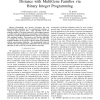138 search results - page 7 / 28 » Advances on sorting by reversals |
CIBCB
2005
IEEE
14 years 1 months ago
2005
IEEE
— Hannenhalli and Pevzner developed the first polynomial-time algorithm for the combinatorial problem of sorting of signed genomic data. Their algorithm solves the minimum numbe...
TCBB
2010
13 years 2 months ago
2010
Markov chain Monte Carlo has been the standard technique for inferring the posterior distribution of genome rearrangement scenarios under a Bayesian approach. We present here a neg...
RECOMB
2008
Springer
14 years 8 months ago
2008
Springer
We study the problem of transforming a multichromosomal genome into another using Double-Cut-and-Join (DCJ) operations. We introduce the notion of DCJ scenario that does not break ...
RECOMB
2010
Springer
13 years 6 months ago
2010
Springer
We study two problems in the double cut and join (DCJ) model: sorting – transforming one multilinear genome into another and halving – transforming a duplicated genome into a p...
CPM
2001
Springer
14 years 11 days ago
2001
Springer
In 1995, Hannenhalli and Pevzner gave a first polynomial solution to the problem of finding the minimum number of reversals needed to sort a signed permutation.Their solution, a...

